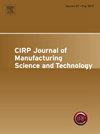Determination of sawing temperature in multi-diamond wire sawing of mono-crystalline silicon carbide
IF 5.4
2区 工程技术
Q2 ENGINEERING, MANUFACTURING
CIRP Journal of Manufacturing Science and Technology
Pub Date : 2025-04-17
DOI:10.1016/j.cirpj.2025.04.004
引用次数: 0
Abstract
4H-silicon carbide (4H-SiC) is a superior polytype SiC known for its wide bandgap, excellent thermal stability, and outstanding electrical and mechanical properties. However, slicing thinner 4H-SiC wafers using diamond wire sawing (DWS) process generates significant heat due to the extended contact length between the diamond wire and work material. This heat adversely affects the surface quality of as-sawn wafers, accelerates diamond wire wear, and poses challenges in accurately measuring the sawing temperature due to the heat dissipation through the unsliced ingot thickness. To address this, the study employed a rocking mode sawing strategy to mitigate the temperature rise caused by the prolonged contact length, while Fourier’s thermal conduction law and finite element analysis (FEA) were employed to accurately evaluate the sawing temperature. The study compares the measured sawing temperatures under rocking mode and traditional sawing conditions with Fourier’s and FEA simulations. Additionally, the effect of sawing temperature on the surface quality of the as-sawn wafer and diamond wire wear has been examined. Results demonstrate that the rocking mode sawing strategy effectively minimizes sawing temperature by 8.266 % in contrast to the traditional sawing process, attributed to its reduced contact length. Fourier’s thermal conduction law analysis proved instrumental in accurately determining sawing temperature. Notably, the rocking mode sawing strategy substantially enhanced the surface quality and reduced the diamond wire wear rate in contrast to the traditional sawing process.
单晶碳化硅多金刚石线锯切温度的测定
4h -碳化硅(4H-SiC)是一种优异的多型碳化硅,以其宽的带隙,优异的热稳定性和出色的电气和机械性能而闻名。然而,使用金刚石线锯(DWS)工艺切割较薄的4H-SiC晶圆时,由于金刚石线与工作材料之间的接触长度延长,会产生显着的热量。这种热量对锯切晶圆的表面质量产生不利影响,加速了金刚石丝的磨损,并且由于热量通过未切片的钢锭厚度散失,给准确测量锯切温度带来了挑战。为了解决这一问题,研究采用摇模锯切策略来缓解接触长度延长引起的温升,同时采用傅立叶热传导定律和有限元分析(FEA)来准确评估锯切温度。通过傅立叶模拟和有限元模拟,对摇摆模式下实测的锯切温度和传统锯切温度进行了比较。此外,还研究了锯切温度对锯片表面质量和金刚石丝磨损的影响。结果表明,与传统锯切工艺相比,摇摆模式锯切策略有效地降低了8.266%的锯切温度,这主要归功于其减少了接触长度。傅立叶热传导定律分析被证明是精确测定锯切温度的工具。值得注意的是,与传统的锯切工艺相比,摇摆模式锯切策略大大提高了表面质量,降低了金刚石丝的磨损率。
本文章由计算机程序翻译,如有差异,请以英文原文为准。
求助全文
约1分钟内获得全文
求助全文
来源期刊

CIRP Journal of Manufacturing Science and Technology
Engineering-Industrial and Manufacturing Engineering
CiteScore
9.10
自引率
6.20%
发文量
166
审稿时长
63 days
期刊介绍:
The CIRP Journal of Manufacturing Science and Technology (CIRP-JMST) publishes fundamental papers on manufacturing processes, production equipment and automation, product design, manufacturing systems and production organisations up to the level of the production networks, including all the related technical, human and economic factors. Preference is given to contributions describing research results whose feasibility has been demonstrated either in a laboratory or in the industrial praxis. Case studies and review papers on specific issues in manufacturing science and technology are equally encouraged.
 求助内容:
求助内容: 应助结果提醒方式:
应助结果提醒方式:


